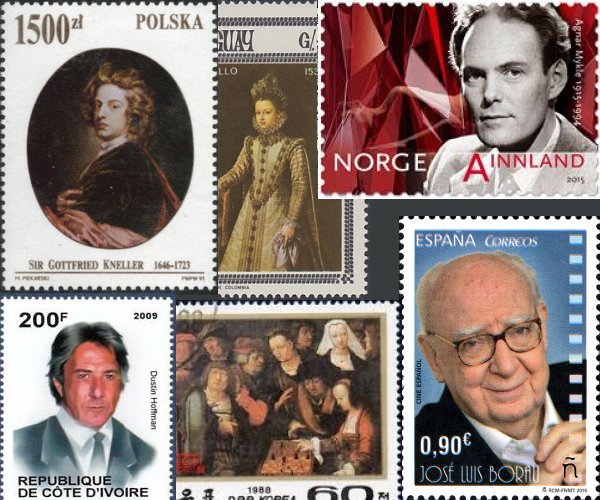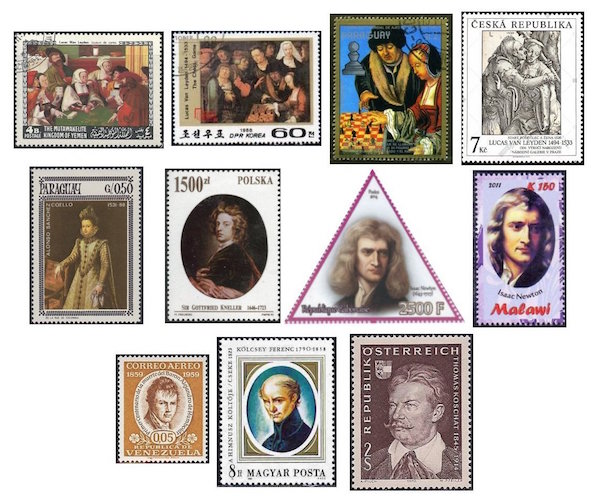The Arts on Stamps of the World — August 8
An Arts Fuse regular feature: the arts on stamps of the world.

By Doug Briscoe
Two rather important painters and Dustin Hoffman shine out among our dozen personalities today.
It seems Lucas van Leyden (1494 – 8 August 1533) was a compulsive student of art from childhood and something of a prodigy. By the time he was twelve he was earning money for his work, and his earliest surviving engraving, Mohammed and the Murdered Monk, executed when he was 14 years old, is thoroughly accomplished. Only seventeen authenticated paintings have come down to us, two of them showing up on stamps. The Card Players (c1508-10) is on a stamp from Yemen, and The Chess Game (c1508) can be seen on stamps of North Korea and Paraguay! Happily one of his many beautiful engravings, A Fool and A Woman (c1520), is also reproduced on a stamp from Czechoslovakia.
Another artist who died on an August 8th was the Spanish portrait painter Alonso Sánchez Coello (1531 – 8 August 1588). Born near Valencia, Coello lost his father at age ten and went to live with his grandfather, who served at the Portuguese court. Thanks to King John III, young Coello was apprenticed to Anthonis Mor in Flanders around 1550. He ended up at the Spanish court of Philip II, where he became court painter in 1560. His work, religious paintings as well as portraits, was praised by Lope de Vega. His 1579 portrait of The Infanta Isabel Clara Eugenia is copied on a Paraguayan stamp.
No slight to Coello, but when I spoke of “two rather important painters” above, I was referring to van Leyden and Sir Godfrey Kneller (8 August 1646 – 19 October 1723), who served as court painter to British monarchs Charles II, James II, William and Mary, Queen Anne, and George I. A German, he was born Gottfried Kniller in Lübeck, studied in the Netherlands, and practiced his craft in Italy before going with his brother John Zacharias Kneller to England in the service of the Duke of Monmouth. He succeeded Sir Peter Lely as Principal Painter to the Crown. He painted the Hampton Court Beauties and was knighted by William III. His sitters were not only royals and their favorites, but also other notables like John Locke and Isaac Newton (in c1689), the latter seen on stamps from Gabon and Malawi. The Polish stamp of 1991 shows one of Kneller’s self-portraits.

Friedrich Georg Weitsch (8 August 1758 – 30 May 1828) was also a court painter, although not for such elevated persons. His patron was the Duke of Brunswick. Having studied with his father and at Düsseldorf, Weitsch painted landscapes, historical and religious pieces, and portraits, including Schiller and Alexander von Humboldt among his sitters. The von Humboldt painting is partly reproduced on a Venezuelan stamp for the great naturalist.
Hungarian poet and literary critic Ferenc Kölcsey (8 August 1790 – 24 August 1838) is most famous for having composed the words to the Himnusz, the Hungarian national anthem (unofficially before 1989). He wrote much other poetry and was also significant as a liberal member of the Hungarian Diet. Orphaned at an early age, he suffered the further hardship of losing an eye to smallpox, an affliction that can be discerned in the portrait used on his stamp.
Thomas Koschat (1845 – 19 May 1914) was the founder of the Koschat Quintet, which toured Europe & America performing Austrian folksongs. Koschat himself sang bass. He wrote nine Singspiels, songs, choruses, and a few dances and marches for orchestra or wind band. Today is the 172nd anniversary of his birth.
Trondheim-born Agnar Mykle (8 August 1915 – 15 January 1994) worked as a journalist in the 1940s and wrote materials in the furtherance of the Norwegian labor movement. He published his first book, a set of short stories, in 1948. His third novel, The Song of the Red Ruby (Sangen om den røde rubin, 1956) became a cause célèbre as the subject of an obscenity case. Although both Mykle and his publisher were acquitted, all copies of the book were ordered confiscated until that ruling was overturned in 1958. But the effect on Mykle was drastic—he became reclusive and limited contact to friends and family for most of the rest of his life. His work, however, had a significant influence on altering sexual attitudes throughout Scandinavia.

We have today two artists best known for their children’s books illustrations. The Hungarian Károly Reich (8 August 1922 – 7 September 1988) was unusually prolific, having illustrated some 500 books. The stamps use two of his creations for a 2010 issue. Born in Mexico City, Rafael López (born August 8, 1961) came to the U.S. for study in 1982 and worked as an illustrator and teacher in Los Angeles and San Diego. In addition to his book illustrations, López has created many paintings, murals, and posters, one of them adopted by the 2008 Obama campaign as an appeal to the Latino vote. Also, he has designed several United States stamps, including this one celebrating the 60th anniversary of the Mendez vs. Westminster court decision, the first desegregation ruling in the country. The stamp we posted here for Carmen Miranda back in February is another of López’s designs.
The Spanish director José Luis Borau Moradell (8 August 1929 – 23 November 2012) was born in Zaragosa and began his career by writing film criticism, directing shorts and commercials, and teaching screenwriting. He made only eleven features, of which the fifth, Furtivos (Poachers, 1975), is the one for which he is most remembered. He also co-wrote and acted in that film.
And a happy birthday to one of the most admired American actors, Dustin Hoffman (born August 8, 1937), seen on stamps from Côte d’Ivoire and Benin.
A graduate of the University of Massachusetts with a B.A. in English, Doug Briscoe worked in Boston classical music radio, at WCRB, WGBH, and WBUR, for about 25 years, beginning in 1977. He has the curious distinction of having succeeded Robert J. Lurtsema twice, first as host of WGBH’s weekday morning classical music program in 1993, then as host of the weekend program when Robert J.’s health failed in 2000. Doug also wrote liner notes for several of the late Gunther Schuller’s GM Recordings releases as well as program notes for the Boston Classical Orchestra. For the past few years he’s been posting a Facebook “blog” of classical music on stamps of the world, which has now been expanded to encompass all the arts for The Arts Fuse.
